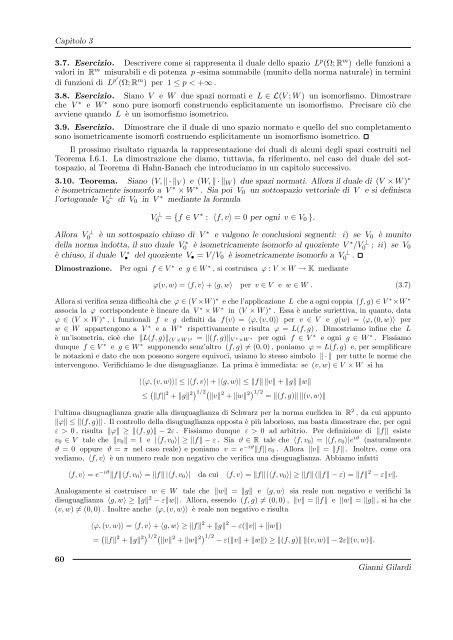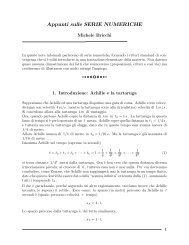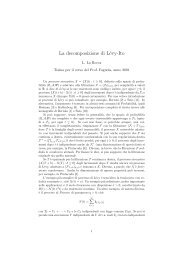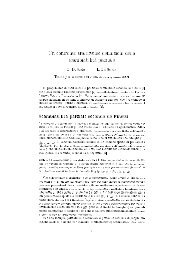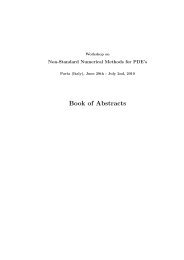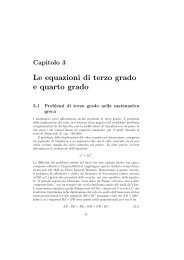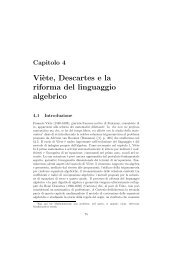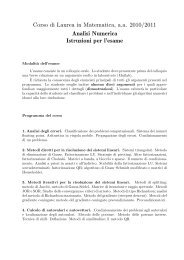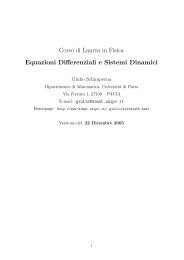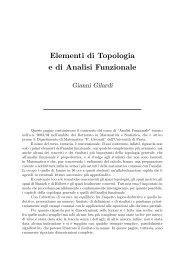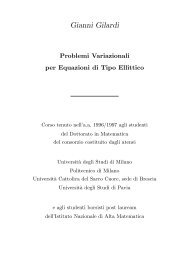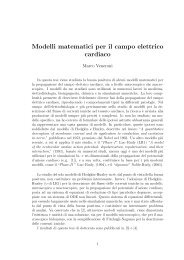G. Gilardi, Analisi Funzionale - Dipartimento di Matematica
G. Gilardi, Analisi Funzionale - Dipartimento di Matematica
G. Gilardi, Analisi Funzionale - Dipartimento di Matematica
You also want an ePaper? Increase the reach of your titles
YUMPU automatically turns print PDFs into web optimized ePapers that Google loves.
Capitolo 3<br />
3.7. Esercizio. Descrivere come si rappresenta il duale dello spazio Lp (Ω; Rm ) delle funzioni a<br />
valori in Rm misurabili e <strong>di</strong> potenza p -esima sommabile (munito della norma naturale) in termini<br />
<strong>di</strong> funzioni <strong>di</strong> Lp′ (Ω; Rm ) per 1 ≤ p < +∞ .<br />
3.8. Esercizio. Siano V e W due spazi normati e L ∈ L(V ; W ) un isomorfismo. Dimostrare<br />
che V ∗ e W ∗ sono pure isomorfi construendo esplicitamente un isomorfismo. Precisare ciò che<br />
avviene quando L è un isomorfismo isometrico.<br />
3.9. Esercizio. Dimostrare che il duale <strong>di</strong> uno spazio normato e quello del suo completamento<br />
sono isometricamente isomorfi costruendo esplicitamente un isomorfismo isometrico.<br />
Il prossimo risultato riguarda la rappresentazione dei duali <strong>di</strong> alcuni degli spazi costruiti nel<br />
Teorema I.6.1. La <strong>di</strong>mostrazione che <strong>di</strong>amo, tuttavia, fa riferimento, nel caso del duale del sottospazio,<br />
al Teorema <strong>di</strong> Hahn-Banach che introduciamo in un capitolo successivo.<br />
3.10. Teorema. Siano (V, � · �V ) e (W, � · �W ) due spazi normati. Allora il duale <strong>di</strong> (V × W ) ∗<br />
è isometricamente isomorfo a V ∗ × W ∗ . Sia poi V0 un sottospazio vettoriale <strong>di</strong> V e si definisca<br />
l’ortogonale V ⊥<br />
0 <strong>di</strong> V0 in V ∗ me<strong>di</strong>ante la formula<br />
Allora V ⊥<br />
della norma indotta, il suo duale V ∗<br />
V ⊥<br />
0 = {f ∈ V ∗ : 〈f, v〉 = 0 per ogni v ∈ V0 }.<br />
0 è un sottospazio chiuso <strong>di</strong> V ∗ e valgono le conclusioni seguenti: i) se V0 è munito<br />
0 è isometricamente isomorfo al quoziente V ∗ /V ⊥<br />
0 ; ii) se V0<br />
è chiuso, il duale V ∗<br />
• del quoziente V• = V/V0 è isometricamente isomorfo a V ⊥<br />
0 .<br />
Dimostrazione. Per ogni f ∈ V ∗ e g ∈ W ∗ , si costruisca ϕ : V × W → K me<strong>di</strong>ante<br />
ϕ(v, w) = 〈f, v〉 + 〈g, w〉 per v ∈ V e w ∈ W . (3.7)<br />
Allora si verifica senza <strong>di</strong>fficoltà che ϕ ∈ (V ×W ) ∗ e che l’applicazione L che a ogni coppia (f, g) ∈ V ∗ ×W ∗<br />
associa la ϕ corrispondente è lineare da V ∗ × W ∗ in (V × W ) ∗ . Essa è anche suriettiva, in quanto, data<br />
ϕ ∈ (V × W ) ∗ , i funzionali f e g definiti da f(v) = 〈ϕ, (v, 0)〉 per v ∈ V e g(w) = 〈ϕ, (0, w)〉 per<br />
w ∈ W appartengono a V ∗ e a W ∗ rispettivamente e risulta ϕ = L(f, g) . Dimostriamo infine che L<br />
è un’isometria, cioè che �L(f, g)� (V ×W ) ∗ = �(f, g)�V ∗ ×W ∗ per ogni f ∈ V ∗ e ogni g ∈ W ∗ . Fissiamo<br />
dunque f ∈ V ∗ e g ∈ W ∗ supponendo senz’altro (f, g) �= (0, 0) , poniamo ϕ = L(f, g) e, per semplificare<br />
le notazioni e dato che non possono sorgere equivoci, usiamo lo stesso simbolo � · � per tutte le norme che<br />
intervengono. Verifichiamo le due <strong>di</strong>suguaglianze. La prima è imme<strong>di</strong>ata: se (v, w) ∈ V × W si ha<br />
|〈ϕ, (v, w)〉| ≤ |〈f, v〉| + |〈g, w〉| ≤ �f� �v� + �g� �w�<br />
≤ � �f� 2 + �g� 2� 1/2� �v� 2 + �w� 2 � 1/2 = �(f, g)� �(v, w)�<br />
l’ultima <strong>di</strong>suguaglianza grazie alla <strong>di</strong>suguaglianza <strong>di</strong> Schwarz per la norma euclidea in R 2 , da cui appunto<br />
�ϕ� ≤ �(f, g)� . Il controllo della <strong>di</strong>suguaglianza opposta è più laborioso, ma basta <strong>di</strong>mostrare che, per ogni<br />
ε > 0 , risulta �ϕ� ≥ �(f, g)� − 2ε . Fissiamo dunque ε > 0 ad arbitrio. Per definizione <strong>di</strong> �f� esiste<br />
v0 ∈ V tale che �v0� = 1 e |〈f, v0〉| ≥ �f� − ε . Sia ϑ ∈ R tale che 〈f, v0〉 = |〈f, v0〉|e iϑ (naturalmente<br />
ϑ = 0 oppure ϑ = π nel caso reale) e poniamo v = e −iϑ �f� v0 . Allora �v� = �f� . Inoltre, come ora<br />
ve<strong>di</strong>amo, 〈f, v〉 è un numero reale non negativo che verifica una <strong>di</strong>suguaglianza. Abbiamo infatti<br />
〈f, v〉 = e −iϑ �f�〈f, v0〉 = �f� |〈f, v0〉| da cui 〈f, v〉 = �f� |〈f, v0〉| ≥ �f� (�f� − ε) = �f� 2 − ε�v�.<br />
Analogamente si costruisce w ∈ W tale che �w� = �g� e 〈g, w〉 sia reale non negativo e verifichi la<br />
<strong>di</strong>suguaglianza 〈g, w〉 ≥ �g� 2 − ε�w� . Allora, essendo (f, g) �= (0, 0) , �v� = �f� e �w� = �g� , si ha che<br />
(v, w) �= (0, 0) . Inoltre anche 〈ϕ, (v, w)〉 è reale non negativo e risulta<br />
60<br />
〈ϕ, (v, w)〉 = 〈f, v〉 + 〈g, w〉 ≥ �f� 2 + �g� 2 − ε(�v� + �w�)<br />
= � �f� 2 + �g� 2� 1/2� �v� 2 + �w� 2 � 1/2 − ε(�v� + �w�) ≥ �(f, g)� �(v, w)� − 2ε�(v, w)�.<br />
Gianni <strong>Gilar<strong>di</strong></strong>


